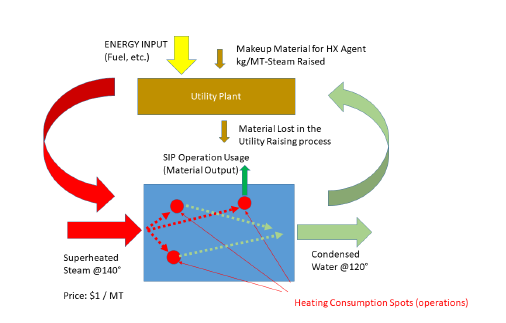
The primary objective of this model is to calculate the amount of steam and material as cleaning agent used for cleaning a piece of equipment.
Available in almost every procedure.
You can specify up to five different contributions for the steam consumption specification:
a) a rate,
b) an amount (per cycle, per equipment unit),
c) a rate per equipment volume,
d) an amount per equipment volume, and
e) an amount per equipment area.
The selected contributions will be added to calculate the total steam amount and the total flowrate. The ‘Cleaning Steam’ is selected from the list of available heating agents. Furthermore the cleaning process will also consume an equal amount of material as cleaning agent. As seen in Representation of how a Heat Transfer Agent is used by a SIP Operation. the Heat Transfer Agent is consumed in its entirety when used in a SIP Operation spot, and therefore an equal amount of material is always consumed and never recycled back to the utility production plant. Finally the same amount of material is also removed as waste.

Representation of how a Heat Transfer Agent is used by a SIP Operation.
The duration of the operation is user-specified. This operation is supposed to be used for cleaning empty equipment items. If material is present in the equipment, the program generates a warning.
A SIP panel can be associated with this operation. If the same panel is utilized by other operations, the program will verity that the processing times of those operations do not overlap.
The interface of this operation has the following tabs:
● Oper. Cond’s, see SIP: Oper. Conds Tab
● Labor, etc, see Operations Dialog: Labor etc. Tab
● Description, see Operations Dialog: Description Tab
● Batch Sheet, see Operations Dialog: Batch Sheet Tab
● Scheduling, see Operations Dialog: Scheduling Tab